How to Give Your Garden (Anywhere) A Tropical Vibe before Summer
What’s In Bloom, What to Plant What to Do!
Here is how to give your garden a tropical vibe. Do you want tropical elements for your garden-wherever it lies? April is the month for active gardening. We make plans, it’s a month to remake the garden for the coming months. If you want more lush tropical style for your garden this summer this is for you! Here is how to add the three “L”s” of tropical growing.
Use these elements, Layers-Leafy-and Large and you’ll have tropical style all summer long and I’ll show you plants that work for your garden-wherever it lies-and how to save those plants over the winter.
“Spring is the time of plans and projects”
-Leo Tolstoy
Whatever subject I am interested in, I like to know what smart and interesting people have to say about it. Comments about April are full of plans, changes and hope. I think this line of Tolstoy’s from Anna Karenina, says it all! April is the time to get things done and fulfill some dreams.
Focus on Tropical Beauty

If you want that tropical style in your garden this summer, here are some plants you can adapt to use in your garden’s hardiness zone.
Plants in bloom for us now in April will give you some ideas for your summer garden space. Then I will highlight those you can either bring indoors, save in a protected area over winter, or use as annuals for your tropical garden.
What’s in Bloom for us Right Now
Plants you can use all summer that we have in bloom, now.
How to Get that Tropical Vibe
Why do so many gardeners want this atmosphere in the backyard? Step into a tropical garden, and you will feel that you are on vacation. Tropical spaces are lush, dense, private spaces that take us all away from the day-to-day world! They are instantly restful and contemplative.
The Three “L’s” of Tropical Gardening
- Make Layers of plantings from low to high. Fill the space
- Choose plenty of Leafy plants, look for variety of size, shape and color.
- Go Large, tropical plants fill the space around you and the foliage is big.
True Tropical Plants You Can Use in Your Cool Climate Garden
- Calla Lily is easy to grow with elegant blooms and sword-like foliage.
- Canna Lily: a true tropical this plant is treasured for its foliage in endless patterns and tones and lily-like blossoms. You plant a corm in the ground, enjoy the pant, trim the stems, and lift the bulb for winter storage when cold weather comes. Here is how to do it.
- Day Lily: these will spread in the garden over the years and provide beautiful, delicate blooms in endless variety. Choose those best suited to your planting zone, there are plenty of choices.
- Elephant Ears: look for Alocasia and Colocasia for well-drained and even wet soil. In a good variety of colors they will provide the large foliage you are looking for.
Cool Climate Perennials That Will Feel Like Tropical Plants
- Hosta, this well loved temperate climate plant will lend your garden the leafy tropical look and feel and in a wide variety of colorful foliage and shape. Interestingly, those of us in South Florida’s hot climate are beginning to use varieties bred just for us. Look for “Sun Hosta.” We use them in zone 10a.
- Lily of the Vally, cold tolerant in zones 2-8. With broad lush leaves, they add a tropical appeal and appreciate the same rich soil as many tropical plants. You can split these in fall to create new plants.
- Japanese Painted Ferns, available in a variety of colors and patterns and are hardy in zones 4-8
- Japanese and Siberian Iris, they will be happy in your zone but blend with your tropical style. There are many colors and varieties, check your zone, many are hardy in zones 2-8.
Annual Plants with Tropical Origins
Many of the annual plants you know and love are really tropical perennials. They are sold worldwide as plants that live their entire lives in one season. However, for those of us who garden in tropical and semi-tropical zones they can last several years.
Try these ideas:
- Impatiens: nothing says tropical and flower-filled, better than any of the varieties of impatiens. Discovered for the world in Livingstone’s search for the Nile River source, there are endless colors and varieties for various light conditions.
- Vinca/Periwinkle: If your planting spot becomes extremely humid try the newest cultivar, Vinca Cora XDR. It is resistant to a long list of fungal diseases. We use these in our community’s extensive annual beds and our summers are stormy and intense.
What To Plant and What to Do This Month
- What to Plant
- What to Do
See below for my chart of useful plants and chores we rely on every April.
Transition In April
In April our South Florida garden is in transition. It is getting warmer. Days pass, and we confront a new and different spring planting season. The actual plant material we can use is changing. The heat will soon affect the workload. We need to get the heavy work done before steamy summer arrives. In our old northern gardens, we would have been testing cold soil for signs of life. In April all of our gardens are making the transition to warm weather. In South Florida, we are just making it faster.
As South Florida Heats Up We Make Plans
As April bubbles on, the weather starts to change the workload. We want to get the heavy pruning and soil maintenance done before summer arrives. Our eyes start to move to new bloom spaces. Some projects move forward, others begin.
Do We Need A Cold Winter To Appreciate Spring?
The very, early American poet, Ann Dudley Bradstreet (1612-1672) held this opinion.
“If we had no winter, spring would not be so pleasant”
-Ann Dudley Bradstreet
The first writer of the new English colonists to be published, her body of work was huge and memorable. Married at 16, mother of 8, she traveled to a wild place on a wooden ship. A poet who wrote between cooking without a stove, washing without, even the dream of, a Maytag, and living without a notion of central heating, she certainly appreciated the end of a harsh winter.
The Question
The question is, do you need the harsh winter to enjoy the spring? I grew up near where she lived and, in a house, built in 1799-beautiful but, well, “chilly”. Has Florida destroyed our taste buds? It does take a while to appreciate what we, who wear flip flops all year, call “seasons”. I think she would laugh at us Florida gardeners. I could not deny her the right, but I still love our little spring. When I walk on the beach, in April, I can take a dip too! Is that enough?
Our Plans And Projects
The New Seating Area
In one area with increasing shade, we have swapped grass for steppingstones and ground cover, added new plants for pollinators, a white flower bed to enjoy from the pool area in the evening, and two entrance arbors for vines and more plants for the littoral shelf of our backyard pond.
The Project
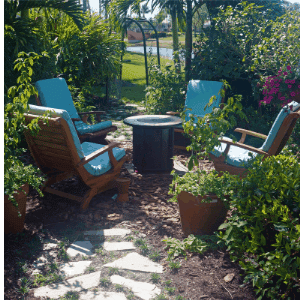
To see how this project to add ground cover and build the pond view seating area worked out, read these two articles. Do they give you any useful ideas?
“How To Find A Low Maintenance Ground Cover That We Love And The Rabbits Do Not”
“Groundcover Update”-about that age-old battle; groundcover vs. the rabbits.
“March in the South Florida Garden“-more on the project.
Abutilon pictum
Charming members of the Malvaceae family, people call them Chinese Lanterns; we planted these shrubs in large pots at both entrances to the seating area. Despite their pretty, common name; they hail from Central America, not Asia! The plant is yet another example of the charm and confusion of the popular names we give to plants. Read this for more information, “Latin for Gardeners“.
These shrubs blossom in four pots surrounding the firepit seating area.
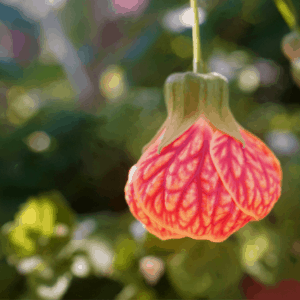
NB: How to read the plant names. Two italicized words together create the plant’s name. First with its first letter capitalized is the genus. Abutilon is a large group of flowering shrubs with papery flowers and maple-like leaves. They have tropical origins, if your climate is cold you can grow some of them as house plants. The second word is the species. Here it is- picture-which means painted.
There are other Abutilon’s and other pictums-but there is only one Abutilon pictum!
An Invitation To The Pollinators
The Abutilon, with its little lantern flowers, is appreciated by bees and hummingbirds.
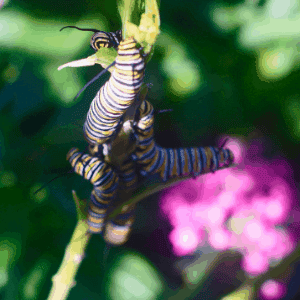
We keep adding milkweed for the ravenous Monarch caterpillars. They can’t get enough!
With its purple trumpets, Philippine Violet (Barleria cristata) is loved by hummingbirds. Still in bloom, it performs for us in cool weather with short days and will eventually fade away until fall. In cooler climates, Texas, for example, it is a warm weather feature. (Its woolly green leaves are appealing when the flowers are not present.)
Firespike (Odontonema cuspidatum), gleefully takes its place with rich magenta blooms on foot-long spikes. It attracts several varieties of butterflies and the neighboring hummingbirds.
All of us gardeners have been taught repeatedly, that one of the hardest jobs in garden design is arranging for a steady progression of blooms. It’s a challenge and the addition of pollinators to provide for makes the job more of an interesting challenge.
Plants In Transition
Winter bloomers will regreen and lose their floral luster. The perennials are Florida-friendly plants for our zone. (10-b) and will be fine this summer. Annuals for containers and bedding areas will change. Spots in the garden, which were green background material all winter, will start to enter the limelight. The rainy season will fatten the ponds, and their edges will bloom. As some wading birds go north, our variety will decrease, but the locals will ply the water’s edge for meals. We can share breakfast in the garden.
Flowering Trees
New trees will gain focus. Our local Hong Kong orchids (Bauhinia blakeana) are slowly ending their long bloom period, but some of the Trumpet trees (mostly Tabebuia) are still in bloom and the blossoms of the tall Jacaranda (Jacaranda mimosifolia) are above us. The panicles of Jacaranda flowers grow 12″ long and the leaves can reach 20″. They will bloom in April, more in May, and through the summer. The magnificent, wide, red, Royal Poinciana (Delonix regia) is a gift, yet to come.
The lush blooms of the Royal Poinciana tree. A wide, spreading tree it’s shade is much appreciated in our warm climate.
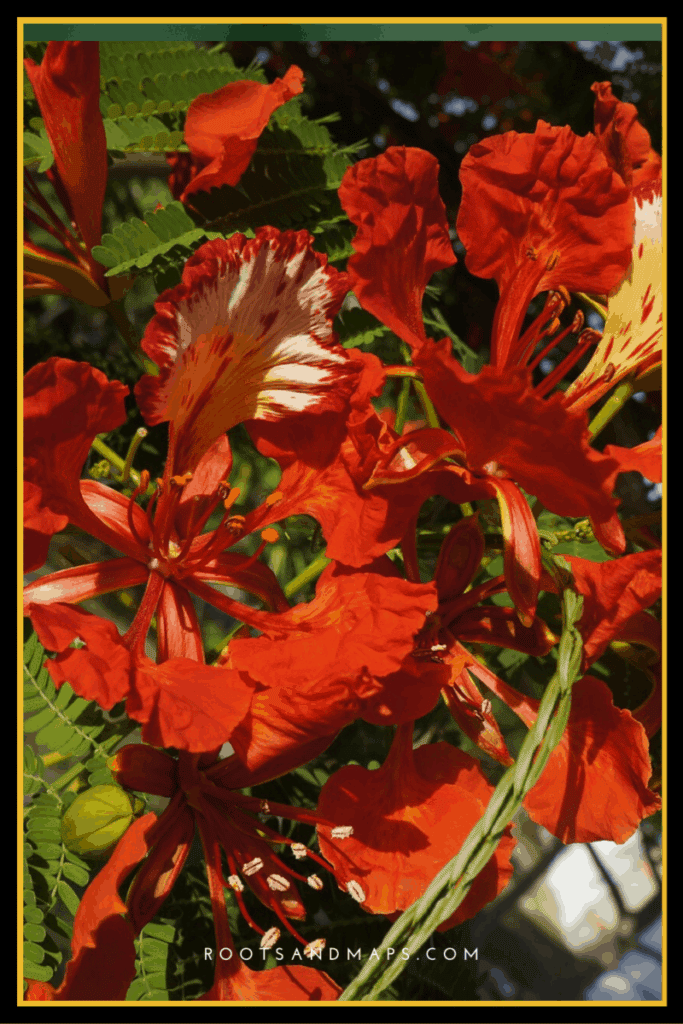
Annuals
In winter we used the same annuals that we would have used in summer in the north. Our petunias are facing their last flourish and pansies are gone. Newer cultivars, bred for our climate help extend our season and reduce needed water. Sunpatiens and Calibrachoa show no signs of ending, so far.
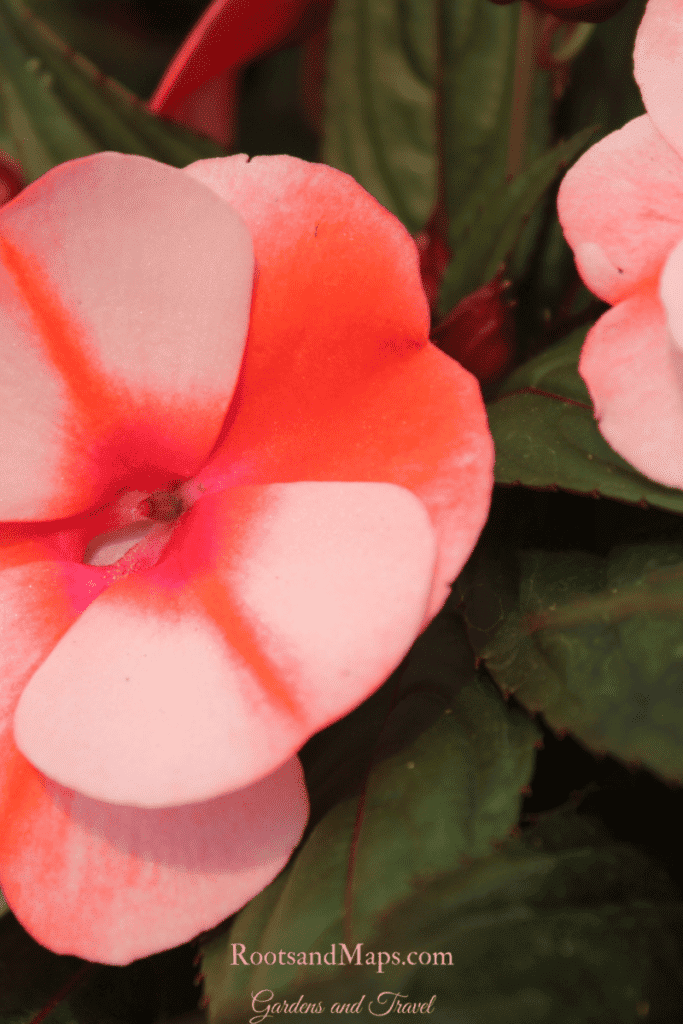
If your garden is in a temperate climate, (most of North America) you will be adding some of these for summer color. Impatiens are wonderful in our winters and these “ sunpatiens” extend the season for us, beautifully. If your summers can get humid these new cultivars may work for you.
Planting Vegetables By State-Use A Hardiness Zone Map
Here is a link to a map with state by state zones and planting information. It reveals the different situations we all face.
Temperatures In April-From Our Different Gardens
This is a list of how our South Florida garden temperatures are changing as spring progresses. Compare them to two other places we have gardened. Boston (high low for April 57-41) Philadelphia (high low for April 66-47). You learn new tricks as you garden in vastly different climates!
- March 79 degrees-61
- April 83 degrees-65
- May 87 degrees-70
What Are We Doing This Month
Pruning
We are pruning. Dombeya-Dombeya wallichii is a large bush that gives us wonderful hot pink blossoms. They sit on the tops of the plants like hydrangeas. It is called a tropical hydrangea around here. Its blooms will be ending soon, and we will reduce the plant’s size. (Lovely and easy to grow, it is also a big bruiser and needs to be treated accordingly.) Cut the spring bloomers right after their bloom period ends. This provides plenty of time for next season’s blossoms to develop. Pruning technique is essential but never overlook timing!
Planting The Littoral Shelf
What is a littoral shelf? It is the shallow, down-sloping extension of a pond or lake. It covers the area that encompasses the high-water mark to the shore and towards the area where sunlight penetrates to the bottom of the water. It is that tricky planting bed that includes places where your plants need to accept both wet and dry conditions and conditions always wet. Planting this bed takes planning but the results can be beautiful and bring you wading birds to enjoy!
Our Littoral Shelf
We have made littoral plantings at the pond edge. The seabirds drop by, and it greatly improves the appearance of the bald edge, and it reduces erosion. On the garden side is a row of grass, Muhlenbergia, which in winter turns a bright magenta color, It is quite spectacular. Now it is cut back and we see the green and yellow next layer,
Our Native Canna flaccida
This is Canna flaccida, a pretty, medium size canna that grows in standing water. A host plant for the Brazilian Skipper butterfly, its luscious yellow flower is orchid-like. In these parts, the locals call it the “Bandanna of the Everglades”. Next to them are Iris Virginiana, the blue flag iris of Florida. We lost some of these in the inundations of Hurricane Irma. These are well established, now, we hope for the best as our hurricane season approaches. We also have Duck Potato; it can handle pretty high levels of water and has a pleasant white blossom.
We have hopes that more of our residents will get involved and improve the appearance of the ponds. At the same time, planting will reduce erosion, an expensive problem in Florida ponds if neglected.
The native grasses and canna lilies provide pondside color and protection for wildlife. This adds charm to what are otherwise drab detention ponds.
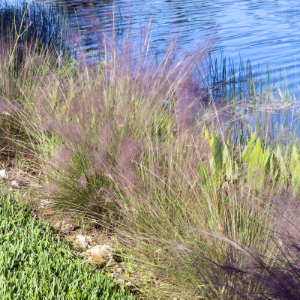
Detention Ponds?
Ponds like ours are pretty surrounding the gardens, but they have an important purpose too. They manage stormwater by storing and cleaning it before it filters along to important water bodies. In our case that’s the Gulf of Mexico!
Summer Blooming Bulbs
In spring-like many gardeners, we plant summer blooming bulbs. This is very little work for a significant benefit of summer color. It is cost-effective too. In March, we took delivery of and planted 100 caladium bulbs and a small group of huge canna bulbs. Here is some more information and some ideas too! This article contains links to more detailed articles on each plant highlighted.
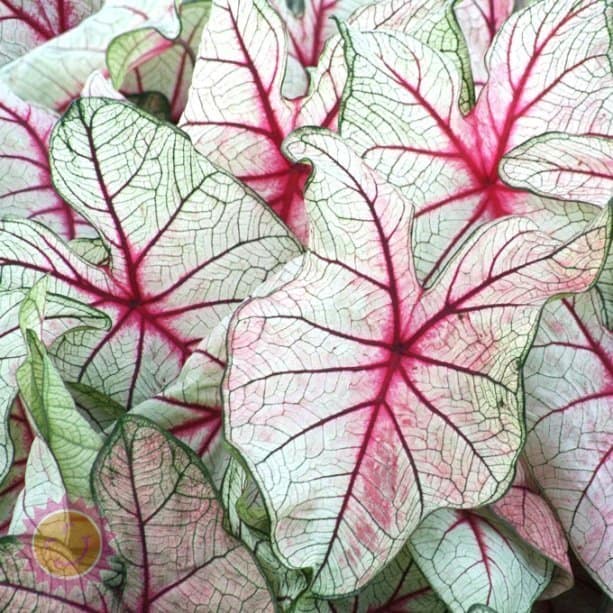
These are called “White Queen Caladiums” they bloom in warm seasons and we leave the tuber in the ground. in colder climates use pots or just dig the tuber up and store in a dry place over the winter. You will get many years of all day, every day pleasure from caladiums.
Try these out for your garden; when you sit out on a summer’s evening, these glow for you as the stars come out!
Soil Testing
We have recently been involved in soil testing for several related gardens. This is perhaps the best way to avoid errors with fertilizers or soil types for your plants. Know Your Soil and what it needs.
How To Read A Soil Test
The numbers are used to identify acidic and alkaline soils. 0.-6.9 is acidic,( 6.5 is the target pH for vegetables, most plants will accept soil pH of 6.0-7.5.) 7 and above is alkaline. If soil is too acidic some nutrients are not available to your plants. If your soil is too acidic for your plant’s calcium, phosphorous and magnesium are not available. However, aluminum and manganese are available at toxic levels. If soil is too alkaline your plants will have reduced availability of nutrients like nitrogen, phosphorus. iron, manganese, and alternatively we will have toxic levels of sodium.
How To Get A Soil Test
Choose for two features, lab expertise, and lab location. Find a high-quality lab and one which is experienced in and tests for your local soil. Perhaps the easiest way to do this is through your local County Extensive Service. If you don’t know them here is how to find them. This is an extension of your state agricultural college. It will be local and expert, It can save you from expensive errors and possible environmental damage too.
What To Plant This Month
| Category | Plants To Include This Month | Resources |
| Annuals | Cleome-spidery like flower, blooms all summer | |
| Coleus, green, red, pink, yellow, orange, maroon. heat tolerant, disease resistant, well-drained soil, | ||
| Vinca-bold color, lavender, pink, red, white. mounding and trailing, A Good Guide | ||
| Angelonia-good in heat, blue, pink, lavender, white, bicolor, Tall, 14″ | ||
| Lantana-color and pollinator attractant. NB the lantana camera is an invasive species | ||
| SunPatiens-will requires more water, In central Fl. we could keep these for 2+ years. In S Fl late summer can be a problem, | ||
| Penta, star-shaped flowers, sturdy in summer, many color choices, two sizes dwarf and regular, this “annual” serves as a permanent plant, lasting for several years. | ||
| Portulaca- low, trailing, sun-loving, low water need | ||
| Salvia-12-24″, red, blue. pink. lavender, good in the center of a container, we like the blue under a peach weeping hibiscus. The rabbits ignore them although they will reach up and steal low growing hibiscus blossoms. | ||
| Torenia-look for new heat and humidity tolerant varieties, 6″ h and 30″ trailing, source of blue | ||
| Wax Begonia-suitable year-round in zone 10-11 | ||
| Zinnia, plant spring or fall for brilliant color and lots of variety, tolerates average to slightly poor soil | ||
| Bulbs | Canna Lily (will thrive in the heat), Caladium, Elephant Ears | |
| Herbs | Basil, Coriander, Cumin, Mint. We are refreshing these plants before the heavy rains come our way. | |
| Vegetables | Beans, Southern Peas, Sweet Potato, |
What to do This Month
| What to do | Steps to Take | Resources to Use |
| Beneficial Organisms | Learn how to use beneficial organisms | beneficial organisms |
| Bulbs | Finish planting summer flowering bulbs/Divide those bulbs over 3 yrs. | Summer Bulbs |
| Perennials | divide herbaceous perennials and grasses | Perennial Division |
| Fruit | Propagate by layering and grafting | fruit Propagration |
| Palms | check for nutritional and environmental disorders | palm nutrition |
| Pests | Prepare for a season of increased bug activities, monitor and identify pests. | spring pests |
| Shrubs | Plant shrubs as you need them. prune spring-flowering shrubs after bloom period | Planting Shrubs |
| Vegetables | Check for any pests, diseases and nutritional issues on plants. Tomatoes will be an issue | Tomato Pests |
Summary,
“The Earth Laughs In Flowers”
– Ralph Waldo Emerson
This is all about work in the garden. What to do and how to get it done! Emerson suggests that we should consider the bigger picture and make sure we relate to and enjoy the spaces we create. Think about some ways to make it enticing and just more fun to be in.
Ideas for Your Garden’s Spring Transition
- Make sure to build in a place to rest and appreciate the garden
- Enhance your space by including your vertical space, include vines and trellises
- Include the sound of moving water
- Add raised beds for convenience and comfort
- Succession plant your lettuce to always have some to enjoy and avoid lettuce feast or famine
- Include your personal style
About That Little Trip!
If you are like us, grateful for the pleasures of the garden, you are also ready to move your feet to see new sights. We’ve got some plans. I’ll be back soon. We all are still, “always in transition” aren’t we? What plans have you got?
